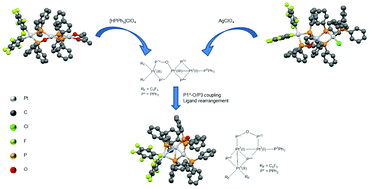Polynuclear platinum phosphanido/phosphinito complexes: formation of P–O and P–O–P bonds through reductive coupling processes†‡
Abstract
A mixture of the asymmetric complexes of formula [(RF)2Pt(μ-Ph2PO)(μ-PPh2)Pt(μ-PPh2)2Pt(solv)(solv′)] [(1-(solv)(solv′)] (solv, solv′ = acetone, H2O, CH3CN) has been prepared by reaction of [(RF)2PtII(μ-PPh2)2PtII(μ-PPh2)2PtII(NCCH3)2] with AgClO4 in CH3CN/acetone. The lability of the Pt–solvent bonds allows the displacement of the coordinated solvent molecules by dppm or Cl− and the isolation of the tri- or hexanuclear phosphanido/phosphinito Pt(II) complexes [(C6F5)2Pt(μ-PPh2)(μ-PPh2O)Pt(μ-PPh2)2Pt(dppm)] (2) or [NBu4]2[(C6F5)2Pt(μ-PPh2)(μ-PPh2O)Pt(μ-PPh2)2Pt(μ-Cl)2Pt(μ-PPh2)2Pt(μ-PPh2)(μ-PPh2O)Pt(C6F5)2] (as a mixture of the two possible isomers 4a and 4b). Complex 2 reacts with AgClO4 to form the tetranuclear derivative [(C6F5)2Pt(μ-PPh2)(μ-PPh2O)Pt(μ-PPh2)2Pt(dppm)Ag(OClO3)] (3), which displays two Pt–Ag donor–acceptor bonds. The mixture of the hexanuclear isomers 4a–4b reacts with Tl(acac) producing the acetylacetonato complex [NBu4][(C6F5)2Pt(μ-PPh2)(μ-PPh2O)Pt(μ-PPh2)2Pt(acac)] (5) which, upon reaction with HCl, yields back the mixture of 4a–4b. The reaction of 4a–4b with PPh3 produces [NBu4][(C6F5)2Pt(μ-PPh2)(μ-PPh2O)Pt(μ-PPh2)2Pt(Cl)(PPh3)] (6) as a mixture of isomers with the chloro ligand located syn (6a) or anti (6b) to the PPh2O− group. Either the reaction of 6 with AgClO4 or the treatment of 5 with HPPh3ClO4 results in the formation of the species [(C6F5)2PtII(μ-PPh2)2PtI(μ-PPh2OPPh2)PtI(PPh3)] (7) (44 VEC), which can be explained as the consequence of a PPh2O/PPh2 reductive coupling and a rearrangement of ligands in the molecule generating a Pt(II),Pt(I),Pt(I) compound. All complexes were characterised in the solid state by XRD (only one of the isomers, in the cases of 4 and 6) and in solution by NMR spectroscopy.

- This article is part of the themed collection: Phosphorus Chemistry: Discoveries and Advances

 Please wait while we load your content...
Please wait while we load your content...